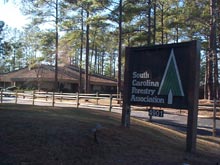
|
|
|
|
|
|
|
|
|
|
 |
|
|
| > APPLICATIONS | ||
| South Carolina Forestry Association | ||
|
In 1991 the South Carolina Forestry Association commissioned a
large study of the state forestry industry. A number of economists
at the University of South Carolina contributed to the overall study.
The model was divided into four major parts: the forest resource base, the logging sector, lumber sawmills, and wood products. A final section that included Critical Variables and Measures of Performance was developed to allow policy planners to try a number of scenarios and quickly view the consequences. The forest resource base included a section on property taxes that yielded a weighted-average tax per acre of timberland. Resource estimates were made for hardwood and softwood including both pulpwood and sawtimber. Each estimation included total acreage, lost acreage under a series of special designations, a set of valuation parameters including growth rates, harvest rates, stumpage values, and discount rates. A discounted value of timberland assuming a fixed price (effectively a zero elasticity of demand) was then computed on a sustained yield basis. In addition, a discounted value of timberland was then computed based on a resource reduction due to Hurricane Hugo. Thus the model computed a discounted value of lost timber for each resource. 
The logging sector model included wage parameters, tax rates, and delivered timber prices. The production function took inputs from the resource section of the model and applied recovery percents to compute production volumes of each resource type. Delivered prices were applied to production volumes to yield revenues from each resource sector. An income statement for the entire logging sector was generated that calculated total income as well as costs per unit of production. The model was designed to show the comparison of a Base Case to a New Case chosen by those examining forestry policy alternatives. The lumber sawmill section was set up in the same way as the logging section with the inputs coming from the logging sector and the outputs going into the wood products sector. Each of the six wood product categories were set up to compute net income after taxes based on the value of shipments, the costs of inputs, wages and taxes. IMS Quantum specializes in developing Integrated Planning Models that show how an understanding of the details of complex interrelated industries can be the basis of more consistent policy planning by government or better corporate strategic planning by participants in the marketplace. |
||

 IMS Quantum was engaged to build an Integrated Planning Model of the
major aspects of the industry to show the quantitative relations between
the different sectors.
IMS Quantum was engaged to build an Integrated Planning Model of the
major aspects of the industry to show the quantitative relations between
the different sectors.